Canon EOS R5 Mark II Review

The Canon R5 has been arguably the most popular camera of the mirrorless age. After 4 years it was long overdue for an upgrade and the Canon EOS R5 Mark II is a significant one. The R5 Mark II should be considered to be Canon's true flagship camera - not the Canon R1, which was an underwhelming release that coincided with the R5 Mark II. The camera features faster readout speeds, a better autofocus system, and 8K/60p RAW video recording. On paper this camera has it all....except perhaps the global shutter found in the A9 III.
But is it enough to warrant an upgrade? For the few underwater photographers holding onto their DSLR Canon 5D Mark IV's - a switch to the Canon R5 Mark II is a no-brainer. However, for the many underwater photographers currently shooting the Canon EOS R5, one of the world's most popular underwater cameras, the R5 Mark II might be a harder sell. It all comes down to autofocus performance...and some of the updates to the autofocus tracking system are mouthwatering.
But of course these paper upgrades are just that - paper. R5 Mark II underwater housings are just starting to hit the market and we have had the chance to dive with the R5 Mark II in an Ikelite housing in Port Hardy, British Columbia during a special photoworkshop. The dive conditions weren't always the most ideal but the R5 Mk II pulled through with some spectacular results. We'd like to thank Bluewater Photo & Travel as well as UB Diving for supporting this review!
US MSRP: $4299
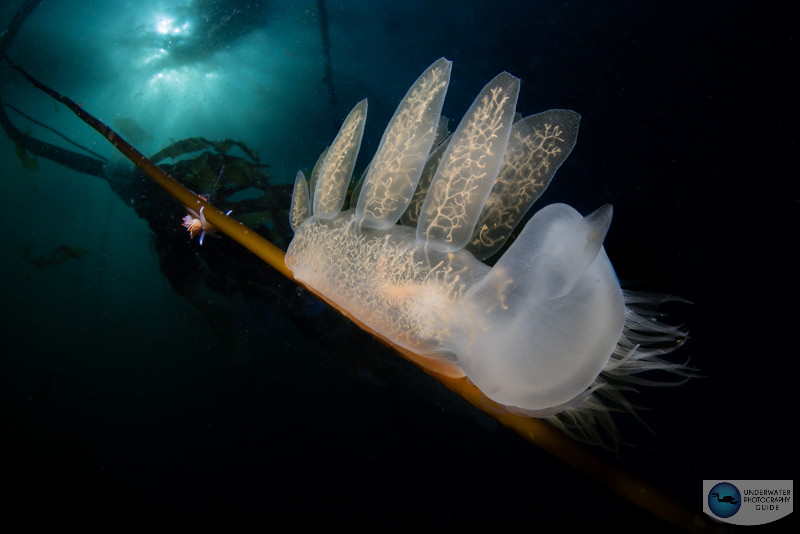
Purchase a Canon EOS R5 II underwater housing at Bluewater Photo:
View All Canon EOS R5 II Underwater Housings
Order an Ikelite Canon R5 Mark II Housing
Order a Marelux Canon R5 Mark II Housing
Order a Nauticam Canon R5 Mark II Housing
Order a Isotta Canon R5 Mark II Housing
Order an Aquatica Canon R5 Mark II Housing
Order a Seacam Canon R5 Mark II Housing
Read Bluewater's Top Underwater Settings for the Canon R5 Mark II
Canon R5 Mark II Specifications
- New 45 megapixel full-frame back-illuminated stacked CMOS sensor
- RF lens mount
- DIGIC X processor with DIGIC Accelerator co-processor
- 30fps RAW burst shooting in electronic shutter mode
- 1/250 mechanical flash sync speed, 1/160 electronic flash sync speed
- Pre-continuous shooting mode
- New Dual Pixel Intelligent AF and AF modes: Action Priority, improved Canon Eye Control AF
- Improved In-Body Image Stabilization
- 8K/60p and 4K/120p video recording
- RAW and C-Log2 Recording capability
- Dual card slots: CFexpress Type B and UHS-II
- 5.76 million dot OLED electronic viewfinder
- LP-E6P battery with improved power output
- Dimensions: 138.5mm x 101.2 mm x 93.5mm
- Weight: 746 grams
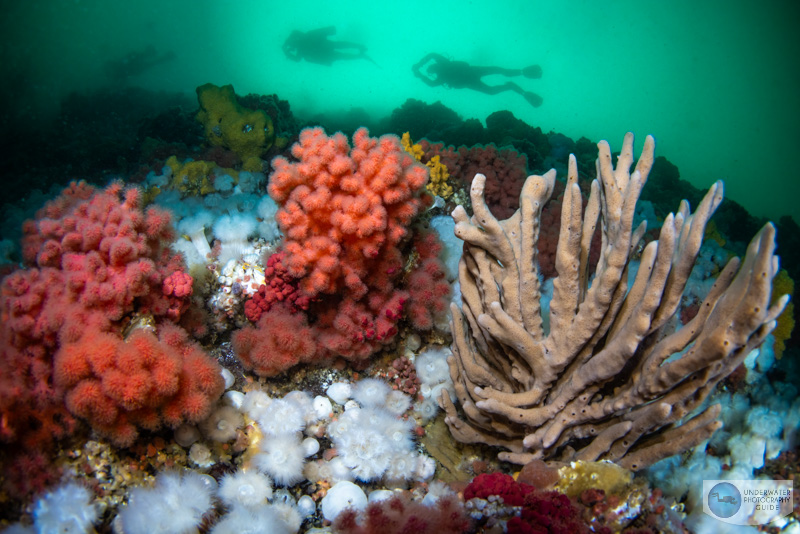
Canon EOS R5 Mark II vs Canon EOS R5
The Canon R5 Mark II is fairly similar to its predecessor. Both cameras feature a 45 megapixel sensor with similar dimensions and controls. That said, there is enough differences in the body, that different underwater housings for the Canon R5 Mark II are necessary and available at Bluewater Photo.
The biggest improvements of the Canon R5 Mark II over the Canon R5 include a new stacked sensor with faster readout speeds and burst shooting, a new autofocus system, eye movement control AF, faster 8K video frame rates, and C-Log2 recording.
The autofocus in the original Canon R5 is already excellent. But if you want the best autofocus system in the world, you'll want to consider the Canon EOS R5 Mark II. Video shooters who are not already shooting the Canon EOS R5 C might want to take a look at the incredible specs on the Canon R5 Mark II. But the R5 C will still be appealing to some - depending on if new underwater housings for the R5 Mark II will be compatible with the cooling battery grip. So far things aren't looking good in that respect with the current Ikelite, Marelux, and Nauticam housings available.
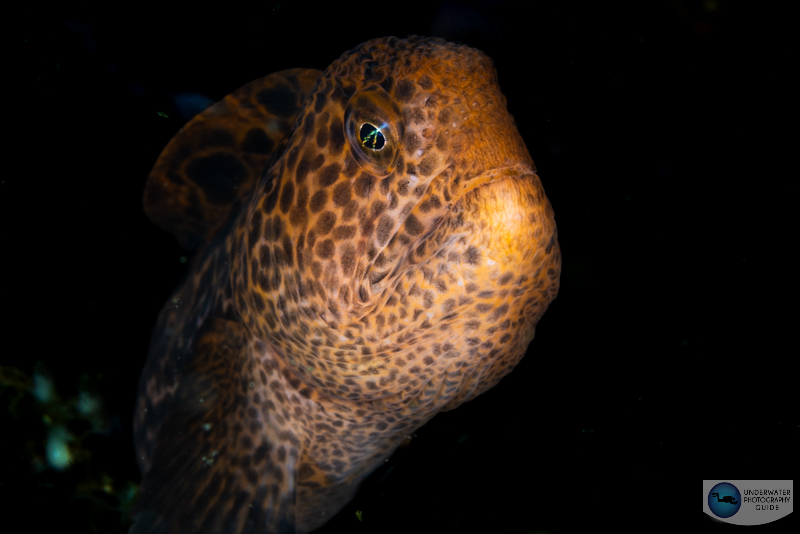
Canon EOS R5 Mark II Key Features

A New 45 MP Stacked Sensor With Faster Readout Speeds
The new arms race in underwater photography is "faster readout speeds" - especially after Sony unlocked the global shutter with the Sony a9 III. For now, the R5 Mark II does not have a global shutter. But it does have the ability to register data on the sensor to the processor extremely quickly with the help of a DIGIC Accelerator co-processor. Another engineering requirement to accomplish this is the new 45 megapixel "stacked" sensor.
Ultimately, rolling shutter is greatly reduced with the new sensor allowing for crisper photos of quick subjects with the electronic shutter as well as less "warpy" video. The video footage we captured underwater was all handheld and extremely stable.
Another benefit of the stacked sensor is quicker burst shooting speeds with the electronic shutter - a whopping 30 fps in RAW! For a 45 megapixel camera this is incredible. And though many underwater photographers shooting with strobes will not utilize burst shooting speeds that fast, the Canon R5 Mark II is capable of using strobes with the electronic shutter (though the sync speed is limited to 1/160s in electronic shutter mode). With fast recycling strobes like the Sea & Sea YS-D3 Duos or the Marelux Apollo IIIs, it will be possible to capture incredible quick subjects in dark waters requiring lower power strobe light.
As with other cameras featuring a stacked sensor - like the Nikon Z8 or Nikon Z6 III - there does appear to be a slight dynamic range trade off for the additional readout speed. Petapixel completed some initial tests comparing the sensor to the original R5, showing some increases in noise. Will it be enough to make a difference for underwater shooters? While stacked sensors typically have less dynamic range than normal sensors, we did not notice a major difference compared to the Canon R5 during our dives. It's certainly not enough to affect our decision when considering the R5 Mark II vs the R5. If you shoot a lot of underwater scenes with high dynamic range (like wide angle sun ball scenes), you may want to consider sticking to your Canon R5. But most other photographers and videographers will not notice. Afterall, the Nikon z8, Sony A9 III, and Nikon Z6 III are all also excellent cameras - even for sunballs.
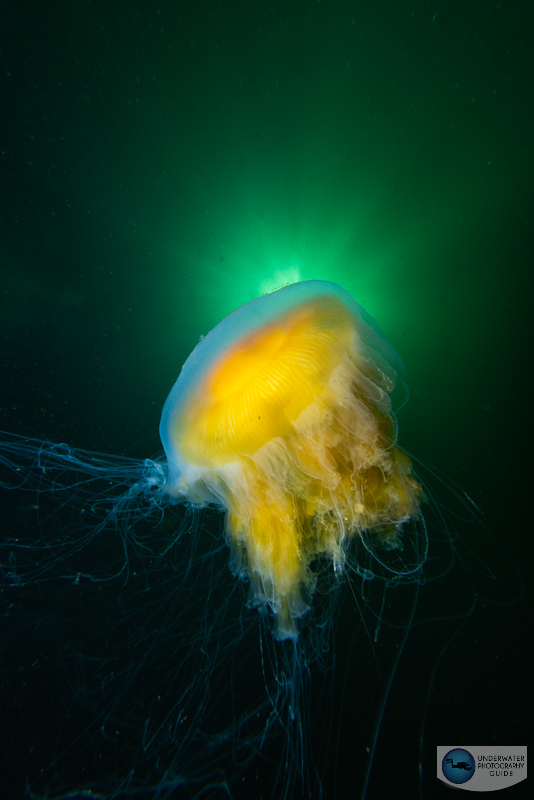
The World's Best Autofocus System
Canon has introduced arguably the world's greatest autofocus system with the Canon EOS R5 Mark II. While Canon's Dual Pixel Autofocus is rated by many to be as good as Sony's subject detection autofocus tracking system - Canon's improvements introduce novel capability. The most important for underwater photography is the fact that the R5 Mark II can ignore a subject if it enters the frame in front of the subject that is being tracked. This can be a huge benefit to someone photographing multiple fish or moving subjects in a frame. This worked really well in the dark water of the Pacific Northwest. Many of our dives was full of particulates and the camera never had an issue tracking the intended subject. Moreover, the overall autofocus speed and acquisition has improved with the additional computational power of the Digic accelerator.
Another interesting feature included in the Canon EOS R5 Mark II is the Canon eye control autofocus initially debuted in the Canon R3. This allows the user to "control" and move the autofocus point with the movement of their eye. Essentially, the camera will focus where you are looking. However, this does not work well when looking through a mask and/or magnified viewfinder. Overall, the feature is not useful for underwater photography.
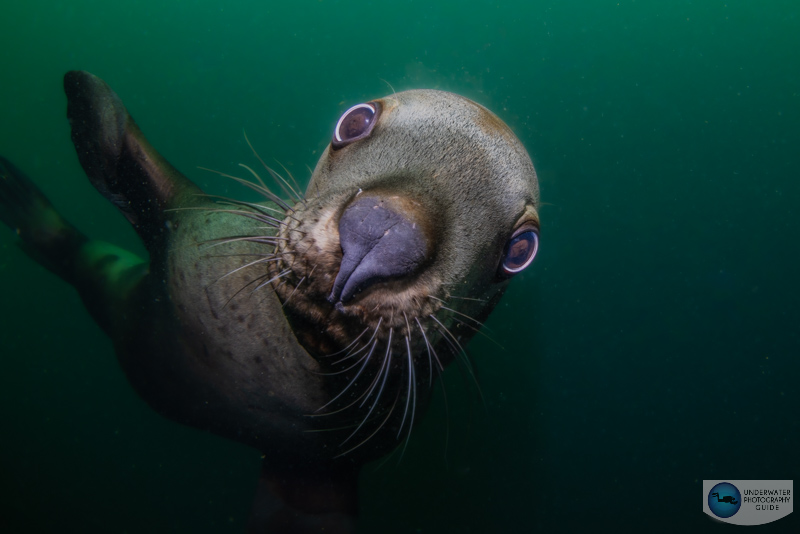
8K Video Improvements and New Recording Capability
The Canon R5 was the first full-frame mirrorless camera to introduce 8K video recording. The R5 Mark II now builds on that with 8K video recording up to 60 frames per second - similar to the Nikon Z8 and Z9. With improved in-body image stabilization and higher frame rates - handheld underwater video is easy. All the footage you can see in this review is handheld. Though most screens are not built for 8K, the ability to film at an 8K resolution enables macro video shooters to crop significantly down to 4K for more reach and additional b-roll. The camera can also film at ultra fast frame rates in 4K up to 120 frames per second - perfect for slowing down quick subjects and adding stabilization.
The R5 II is capable of filming RAW video as well as a new C-Log2 profile. Logarithmic profiles capture more details in the highlights and shadows of video allowing for more dynamic range and flexible editing capability. Most video shooters will likely not film in RAW unless they are working with a production - but the C-Log2 profile is an exciting update that many amateur and enthusiast videographers will use.
Overheating Concerns
The original Canon EOS R5's release did raise concerns when we found out the camera did not last very long recording at high frame rates and resolutions before overheating. We did some initial overheating tests and found that the camera lasted about 20 minutes at 8K and 4K/120p. However, a firmware update greatly improved this performance and the design of the Canon R5C eliminated these issues. The R5 Mark II has a cooling accessory grip, but it's not clear yet if any housings will be compatible with it. While we did not have time in this review to run a full overheating test, the Canon R5 II did not overheat on any dives when we were filming 4K/60p video through the majority of the dive.
Canon EOS R5 Mark II Underwater Housings
With the Canon EOS R5 Mark II being this year's most popular camera, we anticipate the best Canon R5 Mark II underwater housings to be available from every top housing manufacturer. Currently, Nauticam already has an anodized aluminum housing for the Canon R5 Mark II available at Bluewater Photo as well as Marleux and Ikelite's R5 Mark II polycarbonate housing has followed close behind. Marelux, Isotta, Seacam and Aquatica will also likely release their own anodized aluminum housings in the next few months. For our review, we used the Ikelite Canon R5 Mark II housing. It performed excellently with access to all controls on the camera except the joystick. Like the original R5 housing, I needed to get my muscle memory used to using the dials to control settings. Once I did, the camera was faster to use than other cameras that require a D-Pad. Ikelite has updated their dials so that they are more robust and easier to turn with cold water gloves.
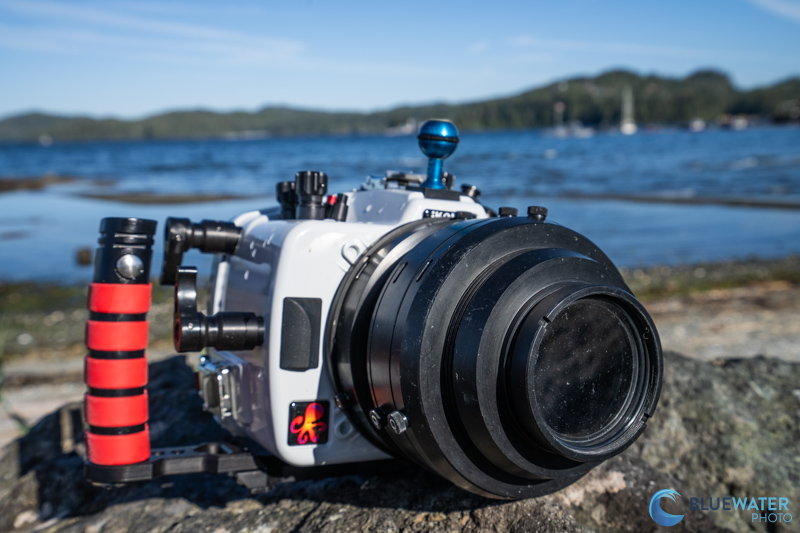
Canon EOS R5 Mark II Underwater Lenses
Macro
Macro lenses are necessary to capture photos of small underwater creatures - usually the size of a golf ball or less.
Canon RF 100mm f/2.8L Macro IS USM: This is the best macro lens for small and shy subjects due to a larger working distance. It’s also an essential tool for supermacro photography when combined with a macro diopter. The Canon RF 100mm macro is a superior lens compared to the EF version because is has an additional magnification and can capture photos at a supermacro 1.4:1 ratio. The Canon RF 100mm is also equipped with a spherical aberration control ring, which we don't recommend for underwater use as it creates a soft look.
Canon EF 100mm f/2.8L Macro IS (with EF-EOS R Adapter): This is a great macro lens for small and shy subjects due to a larger working distance. It’s also an essential tool for supermacro photography when combined with a macro diopter.
Canon RF 85mm f/2.8 Macro Lens: On paper the Canon RF 85mm macro lens looks like a great option for an affordable price. But its autofocus is almost unusable underwater due to the extremely slow moving focusing barrel.
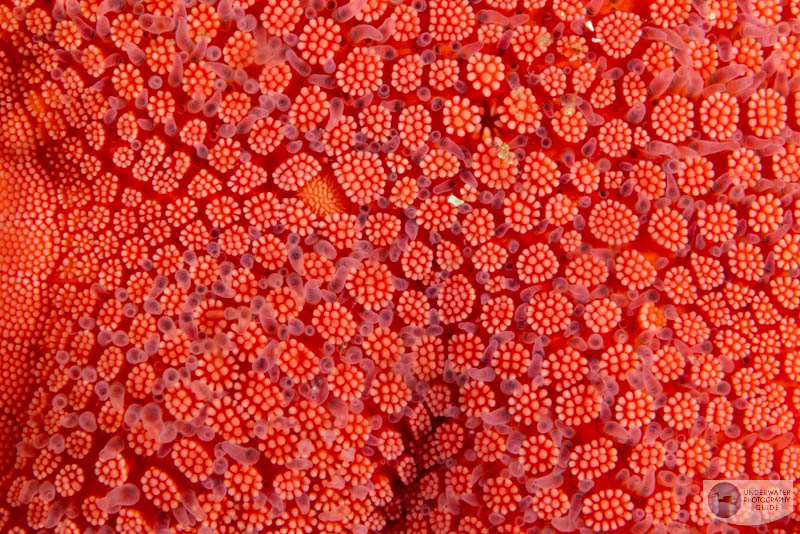
Recommended Wet Diopters
Nauticam Super Macro Converter: The Nauticam super macro converter (SMC-1) is a wet diopter that can help capture sharp macro and super macro images. It’s one of the strongest, sharpest diopter on the market. If you are a super macro photographer, this diopter is best used with the Canon 100 mm f/2.8 macro.
Kraken +13 Diopter and Weefine +13 Diopter: Both of these diopters are equal to the Nauticam SMC in quality for a more affordable price. They are excellent supermacro options that are not too difficult to use but still have incredible magnification. For the most super macro of diopters, we recommend the Kraken +23 and the Weefine +23 but they can be the most difficult to use.
Bluewater +7 Diopter: The Bluewater +7 is our recommended diopter for beginner underwater photographers. While not as much magnification as the rest on this list, it pairs well with mid-range "kit" lenses as well as the Canon 100mm macro for additional magnification.
Read our full guide to underwater macro wet lenses
Wide Angle Fisheye
Wide angle fisheye lenses allow for an ultra-wide field of view. Unlike rectilinear wide angle lenses, they are able to focus much closer to the subject but can result in barrel distortion in the corners of the image. The distortion is reduced underwater to the angle of refraction of light through the water.
Canon EF 8-15mm f/4L circular fisheye (with EF-EOS R Adapter): This is going to be the best choice for a full-frame fisheye lens. At 8mm, the lens vignettes over itself creating a cool, artistic, circular fisheye affect. For traditional fisheye images, just zoom into 15mm and you will capture beautiful ultra-wide angle shots without vignetting.
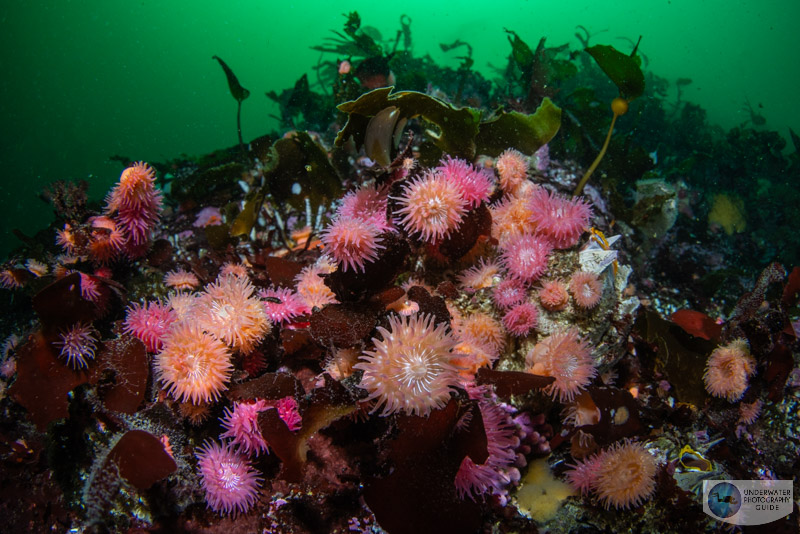
Rectilinear Wide Angle
Rectilinear wide angle lenses retain a wide field of view but do not exhibit the distortion found on fisheye lenses. They are great for large animals like sharks and reefscapes and they can often zoom closer to the subject.
Canon RF 14-35mm f/4 L IS USM: This lens is our top rectilinear wide angle lens choice for underwater photographers using an EOS R style mirrorless camera. With a reduced flange distance in the RF lens mount, the corner sharpness produced by the RF 14-35mm is incredible for a rectilinear lens. That being said, be aware that this lens produces vignetting at 14 mm. Plan on using this lens as a "16-35mm" equivalent. Most underwater shooters use rectilinear wide-angle lenses for shooting subjects that don't come close enough to fill the frame with a wide fisheye lens: sharks, whales, sea lions, dolphins, etc.
Canon EF 16-35 f/2.8 III Ultra-Wide Zoom lens (with EF-EOS R Adapter): This lens is the a great choice for those who are buying their first wide-angle lens and don't have a strict budget. Most underwater shooters use rectilinear wide-angle lenses for shooting subjects that don't come close enough to fill the frame with a wide fisheye lens: sharks, whales, sea lions, dolphins, etc.
Canon EF 16-35mm f/2.8L II Wide-Angle Lens (with EF-EOS R Adapter): This has been the most popular rectilinear wide-angle lens for Canon full frame. This lens sat at the top of the selection for the last few years in terms of corner sharpness, speed, and price... although that will change as more new shooters purchase the version III.
Canon EF 11-24mm f/4L Ultra Wide-Angle Lens (with EF-EOS R Adapter): Want the widest lens you can buy? The Canon 11-24mm offers a much wider field of view than the 16mm. This perspective is great for reefscapes, massive wrecks and very wide shots where you do not want the distortion of a fisheye lens. The downside is that this lens is larger, heavier and more expensive than the other wide-angle lens choices.
Who Should Buy the Canon R5 Mark II
If you need the world's best autofocus tracking system, then you need the Canon R5 Mark II. These new improvements in autofocus allow the R5 Mark II to ignore subjects that may get in the way of your intended target.
If you need incredible video resolution at a high frame rate, then you need the Canon R5 Mark II. While many videographers would be happy with 4K up to 120 frames per second, the added value of 8K video up to 60 frames per second is particularly useful for underwater shooters and puts the R5 Mark II on par with the Nikon Z8 and Z9.
The Canon R5 Mark II is ultimately a camera for the person who needs the best of the best Canon has to offer. While Canon intended to make the Canon EOS R1 their flagship camera - the true flagship is the R5 Mark II. $4299 is not bad at all for a flagship camera.
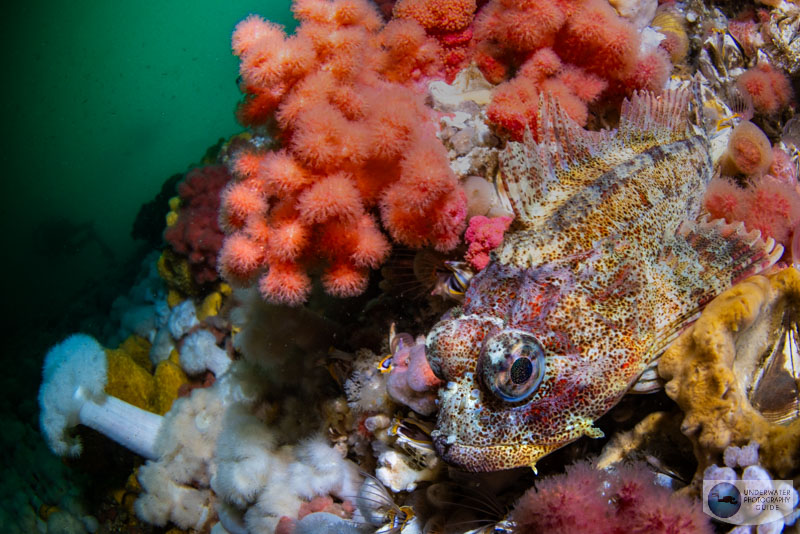
Conclusions
The Canon EOS R5 Mark II continues the trend of extremely fast cameras released from Sony, Nikon, and Canon. With a new stacked sensor and extremely fast readout speeds, you can now shoot up to 30 frames per second RAW photos with strobes with the electronic shutter. However, this does result in a slight loss in dynamic range - which we found to be minimal in our underwater tests.
But most importantly, the Canon EOS R5 Mark II introduces one of the world's most effective autofocus tracking systems with the distinct ability to ignore subjects that might interfere with your intended subject. For underwater photography, this feature alone might convince those on the fence to make the switch to the Canon EOS R5 Mark II.
And finally, as a video camera the Canon R5 Mark II has an impressive set of features including a new C-Log2 profile and 8K video up to 60fps. While many currently shooting the Canon R5C might not be inclined to switch to the R5 Mark II, it does represent a nice upgrade over the original R5. That said, for underwater shooting we will need to run some additional tests to make sure the camera does not overheat to soon without the cooling battery grip.
Overall, the Canon R5 Mark II is an exciting upgrade after long wait and clearly Canon's true "flagship" camera.
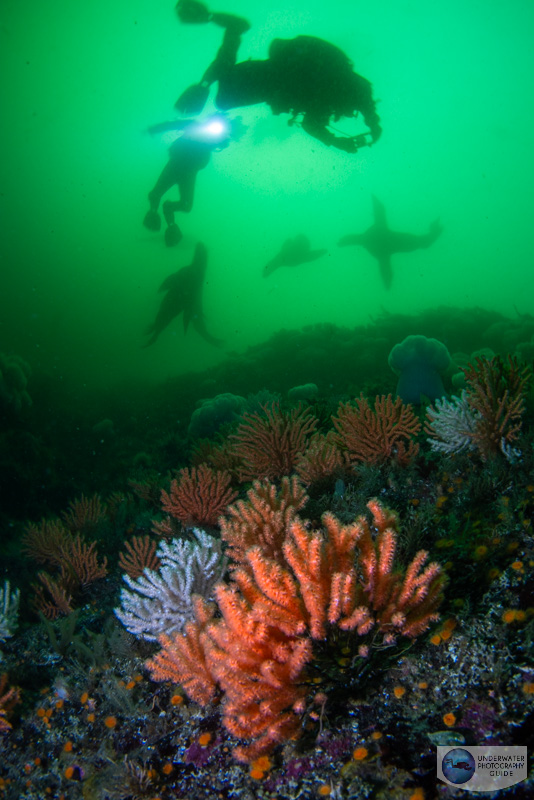
RECOMMENDED ARTICLES
SUPPORT THE UNDERWATER PHOTOGRAPHY GUIDE:
The Best Service & Prices on u/w Photo Gear
 Visit Bluewater Photo & Video for all your underwater photography and video gear. Click, or call the team at (310) 633-5052 for expert advice!
Visit Bluewater Photo & Video for all your underwater photography and video gear. Click, or call the team at (310) 633-5052 for expert advice!
The Best Pricing, Service & Expert Advice to Book your Dive Trips
 Bluewater Travel is your full-service scuba travel agency. Let our expert advisers plan and book your next dive vacation. Run by divers, for divers.
Bluewater Travel is your full-service scuba travel agency. Let our expert advisers plan and book your next dive vacation. Run by divers, for divers.



































